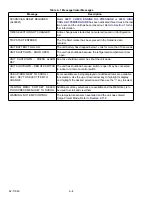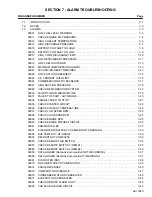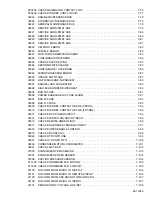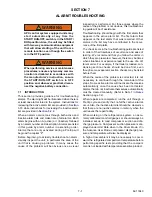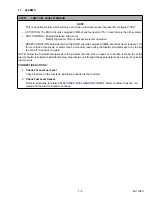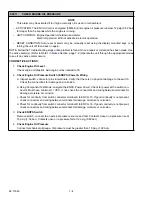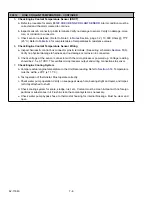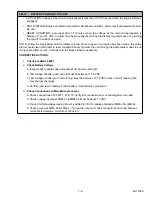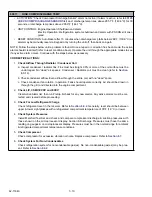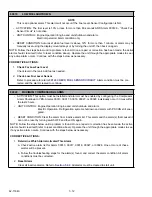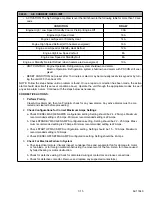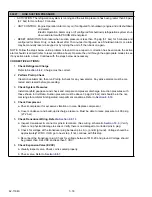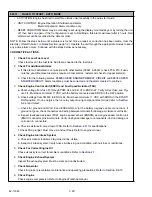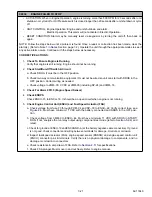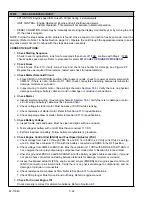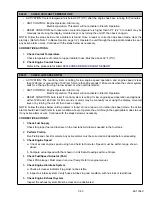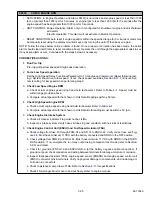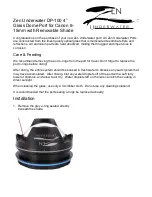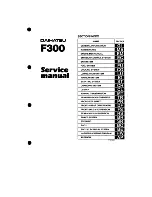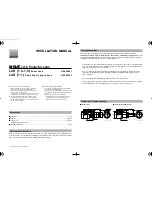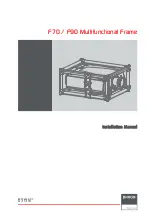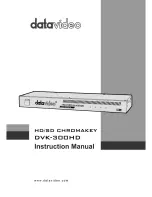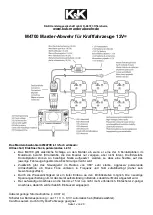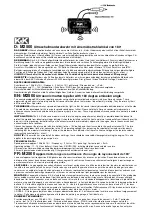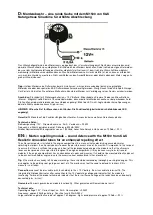
62-11640
7–10
00017
HIGH COMP DISCHARGE TEMP
• ACTIVATION: “Check Compressor Discharge Sensor” alarm not active (if alarm is active, refer to
first) and: discharge temp rises above 285.1°F (140.6°C) for 30
seconds, or discharge temp rises above 295.0°F (146.1°C).
• UNIT CONTROL: Engine Operation: Shutdown and alarm.
Electric Operation: Refrigeration system shutdown and alarm with PSCON still ener-
gized.
• RESET CONDITION: Auto Reset after 15 minutes when discharge temp falls below 266°F (130.0°C) or
alarm may be manually reset via Keypad or by turning the unit off, then back on again.
NOTE: Follow the steps below until a problem is found. Once a repair or correction has been made, the active
alarm should clear itself (refer to reset condition above). Operate the unit through the appropriate modes to see
if any active alarm occurs. Continue with the steps below as necessary.
CORRECTIVE ACTIONS:
1.
Check Airflow Through Radiator
/ Condenser Coil
a. Inspect condenser / radiator fins. Fins must be straight. 90% or more of the coil surface must be
undamaged. No “dead” air spaces. Condenser / Radiator coil must be clean (refer to
).
b. Check condenser airflow. Even airflow through the entire coil, with no “dead” spots.
c. Check condenser fan rotation / operation. Fans should operate correctly. Air should be drawn in
through the grill, and directed into the engine compartment.
2.
Check LIV, CSMV, EVXV and
ECXV
Clear Active Alarm list, then run Pretrip & check for any new alarms. Any active alarms must be cor-
rected and cleared before proceeding.
3.
Check For Low Refrigerant
Charge
Check refrigerant level in the receiver. Refer to
. Generally, level should be between
upper & lower sight glasses with a refrigerated compartment temperature of 35°F (1.0°C) or lower.
4.
Check System
Pressures
Install Manifold Test Set and check and compare compressor discharge & suction pressures with
those shown on the microprocessor display. Suction & Discharge Pressures must have the same
reading on gauges & on microprocessor display. Pressures must be in the normal range for ambient
& refrigerated compartment temperature conditions.
5.
Check
Compressor
Check compressor for excessive vibration or noise. Replace compressor. Refer to
6.
Check System For Non-Condensables
Check refrigeration system for noncondensable gas(es). No non-condensable gas(es) may be pres-
ent. Refer to
Summary of Contents for Vector 8500
Page 23: ...62 11640 1 6 1 3 SAFETY DECALS ...
Page 24: ...1 7 62 11640 62 03958 ...
Page 25: ...62 11640 1 8 ...
Page 26: ...1 9 62 11640 ...
Page 27: ...62 11640 1 10 ...
Page 125: ...62 11640 SECTION 6 MESSAGECENTER PARAGRAPH NUMBER Page 6 1 MESSAGECENTER MESSAGES 6 1 ...
Page 321: ......
Page 322: ......

